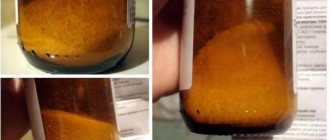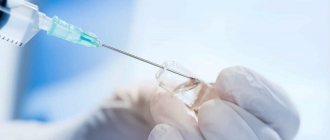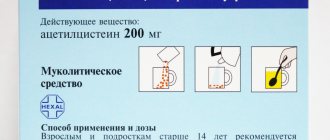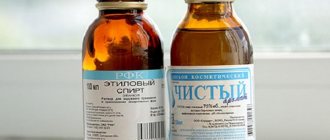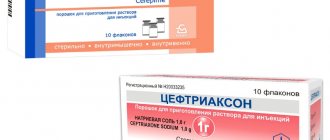Ceftriaxone must be diluted with 1% lidocaine solution. For 1 g of powder you will need 3.5 ml of solvent. If only 2% Lidocaine is available in the pharmacy, it is diluted with water for injection to the required concentration - mix 1 ampoule of each, that is, take for 1 injection:
- bottle of Ceftriaxone 1 g;
- ampoule of water for injection (2 ml);
- ampoule of 2% Lidocaine (2 ml).
If you need to administer part of the dose (usually to children), then after dilution, take the required volume. The prepared solution can be stored in the refrigerator for 12 hours. Novocaine is not recommended for use due to the risk of severe allergic reactions.
The drug Ceftriaxone: how to dilute Lidocaine
Ceftriaxone is diluted with a 1% solution of Lidocaine (local anesthetic); for this, 1 g of antibiotic powder must be mixed with 3.5 ml of solvent. If such a concentration is not commercially available, then 2% Lidocaine must be diluted with water for injection. Then take 2 ml of water and 2 ml of 2% Lidocaine at a time.
Dosage for children and adults
The average daily dosage for children and adults of Ceftriaxone with the required volume of solvents is shown in the table.
| Patient category | Ceftriaxone | 1% Lidocaine | Water for injection with 2% lidocaine solution |
| Adults and children over 12 years old, teenagers weighing over 50 kg | 1-2 g, maximum 4 g | 3.5 ml per 1 g | 2 ml each |
| Newborn up to 2 weeks of life | 20-50 mg per 1 kg of body weight | 3.5 ml of 1% or 2 ml of water and 2% Lidocaine per 1 g, take the required amount, discard the remainder | |
| From 2 weeks to 12 years | 20-80 mg per 1 kg of weight, maximum 100 mg/kg | ||
The dose of antibiotic is always selected individually; it depends on the severity of the infectious disease and diagnosis. For children, it is more convenient to use 500 mg bottles, then there is less to throw away, but they practically never appear on sale.
If this particular release form is available, then to dilute 500 mg of Ceftriaxone you need 2 ml of 1% Lidocaine or 1 ml of water for injection and 2% anesthetic solution.
We recommend reading the article on how to use Ceftriaxone for sore throat. From it you will learn about the advantages and disadvantages of Ceftriaxone for angina, treatment regimens in adults and children, and side effects. And here is more information about Ceftriaxone analogues.
How to dilute 2 lidocaine to 1 percent
Lidocaine is used to dilute the antibiotic Ceftriaxone at a concentration of 1%, but such a percentage of the solution is rarely available in pharmacies, so you can dilute 2% to 1%; for this, take 2 ml of water for injection for 2 ml of 2% Lidocaine.
The instructions for the drug indicate that the volume of the solvent should be 3.5 ml, and if you dilute a 2% solution, you will end up with 4 ml. This difference (0.5 ml) does not affect the treatment process in any way. A slightly larger volume is even better, since Ceftriaxone is quite difficult to dissolve.
Lidocaine Water for injections
Is it possible to inject without Lidocaine?
Ceftriaxone can be injected without Lidocaine in the following cases:
- intolerance (allergy);
- contraindications to painkillers: liver disease, circulatory failure, heart block, old age, pregnancy, lactation;
- intravenous injections and drips (Lidocaine is prohibited as it can cause heart rhythm disturbances).
For dilution then only water for injection is used in an amount of 4 ml (2 ampoules). Antibiotic injections into the buttock without pain relief are very painful.
How to dilute Ceftriaxone with Lidocaine and water
To dilute 1 g of Ceftriaxone with 2% Lidocaine and water you need:
- Open an ampoule containing 2 ml of water for injection and draw the contents into a 5 ml syringe.
- Open the ampoule with 2 ml of 2% Lidocaine and add the solution to the same syringe.
- Remove the protective cap from Ceftriaxone and pierce the rubber cap with a needle.
- Inject the entire contents of the syringe into the bottle.
- Shake the mixture of antibiotic and solvent vigorously until the solution becomes completely clear (the needle and syringe do not detach).
Then you should fill the syringe with the entire solution or the required amount, change the needle and inject into the buttock muscle (upper outer quadrant). It is best to prepare Ceftriaxone with Lidocaine and water for one injection, but it happens that only half of the prepared solution is used. Then the remainder in the bottle is placed in the refrigerator.
Watch the video on how to dilute Ceftritaxone:
How to inject Ceftriaxone with Lidocaine
If you use a 1% solution of Lidocaine to dilute Ceftriaxone, then water is not needed, but the injection should be done according to this scheme:
- Fill a syringe with 5 ml of painkiller in a volume of 3.5 ml.
- Add to antibiotic bottle.
- Achieve complete dissolution.
- Draw the solution into a syringe.
- Change the needle (it is most convenient to use three-component syringes for Ceftriaxone), since during dissolution there are cases when the needle becomes clogged with antibiotic powder.
- Remove air from the syringe.
- Give an injection.
One injection into the muscle takes only 1 g of the drug. It is done once a day. If you need to administer 2 g, then usually 2 injections of 1 g are given with an interval of 12 hours with a mandatory change of side. When higher doses are indicated, the patient is often recommended to receive a drip 1 or 2 times a day.
How to give intramuscular injections
An intramuscular injection of a diluted antibiotic is given according to the rules:
- Visually divide the buttock into 4 parts (the first time you can draw the boundaries with a cotton swab soaked in iodine) in half vertically and into 2 equal parts horizontally.
- Find the upper outer quadrant.
- Wipe the injection area with alcohol (there should be no lumps or pain in it).
- Take the syringe in your right hand, and with your left hand fix the skin with the first and second fingers, stretching it significantly.
- With a precise and quick movement, pierce the skin and insert the needle strictly perpendicular to 3/4 of its length.
- Slowly press the plunger and gradually release the solution.
- Remove the needle.
- Press the injection site with an alcohol swab and hold for 1 minute.
It is very important to adhere to the rules of complete sterility when diluting an antibiotic yourself. This means that your hands are washed thoroughly, and then your fingers and the cap of the bottle are wiped with alcohol. All manipulations are carried out on a sterile napkin; the needle outside the ampoule and bottle should be kept closed with a cap.
Release form and solutions for diluting the antibiotic
Like most antibiotics, the active substance of the drug Ceftriaxone is not supplied in the form of a ready-made solution, but in the form of a slightly yellowish or white crystalline powder. It is placed in transparent glass bottles with a rubberized stopper and an aluminum cap. This was done for reasons of preserving the activity of the active substance - ceftriaxone. The powder is easily soluble in water (dissolution time should be no more than 2 minutes according to the standard), very slightly soluble in ethanol. The resulting substance varies in color from light yellow to amber, depending on the shelf life, the type of solvent used and the concentration of the drug.
Novocaine
The drug is dispensed from pharmacies in bottles of 0.25, 0.5, 1 or 2 grams in the form of sterile sodium salt of Ceftriaxone. The most common dosage is 1 g. The instructions for medical use of the drug say that this medicine can be administered exclusively parenterally: intravenously or intramuscularly. Once in the body using one of these methods, the drug is completely absorbed and bioavailability is 100%. The powder can be diluted with water for injection or anesthetics (Lidocaine, Novocaine). These are common liquids for diluting antibiotics. The choice of solution depends on the route of entry of the drug into the body. If a doctor writes a prescription for Ceftriaxone for intramuscular administration, then it is permissible to use any of these solutions. If the medicine must be administered intravenously, the only liquid allowed is water for injection. Lidocaine and Novocaine are strictly prohibited for this purpose.
Is it always possible to dilute Ceftriaxone with Lidocaine?
Ceftriaxone can be diluted with Lidocaine only for injection into the muscle. Injections into a vein are made with water, and when using droppers, saline solution or 5% glucose is allowed as a solvent.
If you accidentally administer a mixture of antibiotic and painkiller intravenously, there is a risk of:
- disturbances in the conduction of the heart muscle, up to complete blockade (the nutrition of vital organs is disrupted);
- slowing down the rhythm of contractions (the brain and myocardium do not receive the required volume of blood);
- a drop or sharp increase in blood pressure;
- fainting, vascular collapse.
Saline solution 5% glucose solution
In patients with lidocaine intolerance, cardiac and liver failure, it is best to use water for injection for dissolution. If at the same time unbearable pain occurs, then they change the method of administration - they put in droppers or give injections into a vein. When none of these options are suitable, the doctor may replace Ceftriaxone with another drug with a broad antibacterial effect.
Possible complications
If Novocaine is well tolerated (no allergy), it rarely causes complications. Possible side effects in isolated cases:
- headache;
- dizziness;
- fainting;
- convulsions;
- hand trembling;
- weakness in the legs;
- numbness of the tongue and lips;
- worsening breathing;
- noise in ears;
- blurred vision;
- vomiting, nausea;
- blood pressure surges;
- interruptions in heart rhythm;
- itchy skin;
- rashes;
- sweating
Nausea
Is it better to dilute Ceftriaxone with Novocaine or Lidocaine?
It is better to dilute Ceftriaxone with Lidocaine than Novocaine, this is explained by the properties of the second painkiller:
- reduces the effectiveness of the antibiotic;
- acts weaker;
- Lidocaine more often causes allergic reactions, including the immediate type - angioedema.
If you are intolerant to Lidocaine and need to use intramuscular injections, the doctor may allow dilution of the antibiotic with 4 ml of a 0.5% solution of Novocaine.
In such cases, a preliminary test is required. It is carried out with 0.5 ml of a ready-made mixture of Ceftriaxone with an anesthetic. This amount is injected under the skin of the forearm and then the reaction is assessed hourly. Novocaine can also be used in the treatment of animals.
It is strictly forbidden to change the solvent yourself; it is especially dangerous to use solutions with calcium (for example, Ringer), as insoluble salts are formed. You cannot inject Ceftriaxone at the same time (in the same syringe) with other antibiotics.
Which is better - intramuscular or intravenous?
For Ceftriaxone, intravenous injections are better than intramuscular injections for severe infections. Moreover, both routes of administration have high antibacterial effectiveness, but differ in pharmacokinetic properties, that is, in the rate of entry into the blood and elimination (see table).
| Parameter | Intramuscular injections | Intravenous injections |
| When it enters the blood | In 30 minutes | At once |
| Time of maximum concentration | In 2-3 hours | At the end of the injection |
| Half-life | 6-8 hours | 8-16 hours |
| How much can you enter at one time? | 1 g (one way) | 1-4 g |
It is better to inject an antibiotic into a vein in such cases:
- high doses are needed (from 2 to 4 g per day);
- there is intolerance to lidocaine (painkiller);
- Treatment is carried out on a newborn or a child under 3 years of age.
Recipe
To purchase Ceftriaxone, you need a prescription from a doctor; it is prescribed according to this example:
Rp.: Ceftriaxoni 1.0
- td no. 7
- Dilute the contents of the bottle with 4 ml of 1% Lidocaine and administer intramuscularly once a day for 7 days.
Contraindications to antibiotics
Ceftriaxone is contraindicated in case of intolerance or allergy to any drug from the group of cephalosporins, penicillins, carbapenems. This antibiotic cannot be administered intramuscularly in case of allergic reactions to lidocaine or a ban on its use (epilepsy, heart rhythm disturbances - blockade, bradycardia, weakness of the sinus node).
There are special restrictions for newborns:
- premature;
- the need to introduce calcium salts;
- increased level of bilirubin in the blood, jaundice;
- low protein levels;
- a shift in blood pH to the acidic side (acidosis).
Side effects
Ceftriaxone is a non-toxic drug, but its use is always carried out under the supervision of a physician due to the risk of adverse reactions:
- digestive system - diarrhea, intestinal dysbiosis, nausea and vomiting, abdominal pain, loss of appetite and unpleasant taste in the mouth;
- biliary tract - precipitation of salts, increased bilirubin and liver enzyme activity, drug-induced hepatitis, jaundice;
- blood - increased eosinophils (a sign of allergy), decreased leukocytes (responsible for immunity), platelets (increased bleeding), anemia;
- nervous system – dizziness, headache, convulsions;
- kidneys and urinary tract - deterioration of renal function, decreased urine output, salt deposition in the kidneys;
- immunity - allergic reactions, including the rapid increase in swelling of the face and neck, urticaria, anaphylactic shock, rashes; due to decreased immunity, the development of thrush or a second infection is possible;
- respiratory tract - bronchospasm with paroxysmal cough;
- local reactions – pain upon insertion, hardening.
If any unusual symptoms appear during treatment, you should consult a doctor.
Where to store lidocaine for dilution
Lidocaine ampoules for dilution of 1% or 2% concentration are stored in a place protected from light at room temperature (from 15 to 25 degrees). Exactly the same conditions are needed for vials of Ceftriaxone and water for injection.
We recommend reading the article about the combined use of Azithromycin and Ceftriaxone. From it you will learn about which antibiotic is stronger, the compatibility of drugs, and for what diseases they can be combined. And here is more information about the rules for using Ciprofloxacin and Ceftriaxone.
Ceftriaxone should be diluted with a 1% lidocaine solution or diluted with a 2% solution of water for injection. This helps reduce the pain of injections in the buttock. For intravenous administration, only water or saline solution and glucose are used.
Doctors' opinions on drug compatibility
Doctors using Ceftriaxone with Lidocaine have noted that allergic reactions rarely occur. Novocaine intolerance is more common, and it can be in the form of rapidly developing swelling of the face, neck, and deterioration in breathing, which requires urgent resuscitation measures. Therefore, when diluting an antibiotic, which itself provokes allergies, it is better to use Lidocaine.
If you are prone to intolerance to any medications or diseases with an allergic component (for example, bronchial asthma, seasonal rhinitis), a skin test before starting treatment is strictly required.
We recommend reading about Ceftriaxone for cats. From the article you will learn when Ceftriaxone is prescribed for cats, how to properly dose and inject a cat, as well as how much to inject the drug and its analogues. And here is more information about how to properly treat dogs with Ceftriaxone.
Ceftriaxone is diluted with 0.5% Novocaine in case of individual sensitivity to Lidocaine, manifested in allergic reactions. Novocaine solution is also used in the treatment of animals, contraindications to lidocaine. Skin tests are required before the first injection.
